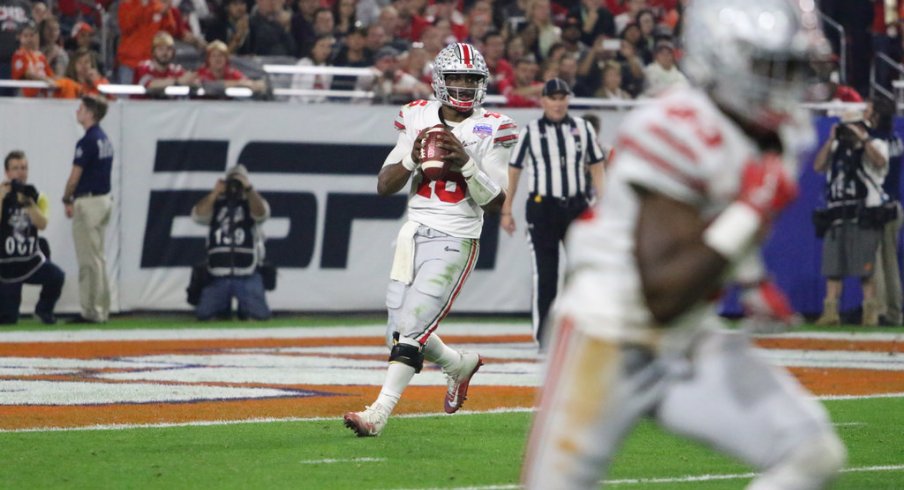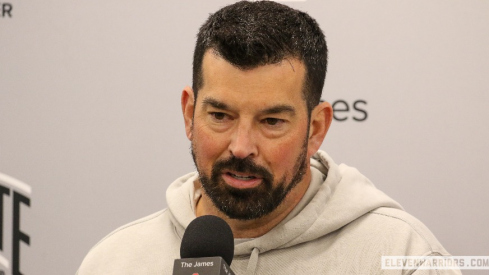Throughout its 126 years of playing football, Ohio State has never been known for its ability to throw the ball.
Though the program has produced eight national championship seasons, seven Heisman winners, and 83 consensus All-Americans, only one quarterback has earned a tree in the Buckeye Grove since 1979. Since the timing patterns and route concepts that now make up the 'modern' passing game were widely adopted in the late 1980s and early 90s, Ohio State has rarely featured a premier passing game.
While Troy Smith's 2006 Heisman season re-wrote many of the school's record books, the Buckeyes were still only the 45th-best aerial attack in the nation that fall. Since then, the best showing was the 2014 team that only ranked 52nd in passing yards-per-game, just barely cracking the top half of FBS teams in the category. Despite regularly contending for national championships throughout this period, the Buckeyes have relied far more heavily on a physical ground game under both Jim Tressel and Urban Meyer than dazzling passing displays.
Yet, many believe this lack of success through the air was the reason the most recent Buckeye squad was unable to fulfill their championship potential. Not only did the offense fail to consistently move the ball through the air against when facing their toughest competition (Penn State, Michigan, and Clemson), they struggled mightily against lesser opponents like Indiana and Michigan State as well.
Though there were some bright spots along the way, the unit's inconsistency was a regular point of discussion, even as the team marched along to a spot in the College Football Playoff. After consecutive seasons with a lackluster passing game, though, the heat was turned up on coordinators Ed Warinner and Tim Beck.
To place blame solely on the play-calling is unfair, as there were consistent issues across the entire unit that led the Buckeyes to this point. Most notably, it became clear right away that only one wide receiver, Curtis Samuel, seemed capable of filling the void left by the departures of Michael Thomas, Jalin Marshall, and Braxton Miller after the previous season.
By midseason, it had become clear to both the fans and opposing coaches that Samuel had become the focal point of every Buckeye game plan. To get him the ball, Warinner and Beck actually did a good job of incorporating wrinkles to free him up on core passing concepts such as 'H-Option' and the deep 'Flood' routes like the one below.
Yet many of the duo's best ideas were all for naught, as inexperienced players like Parris Campbell, James Clark, and Terry McLaurin, who saw their first significant playing time last fall, often failed to execute even the simplest of roles. Not only did receivers not named Samuel often fail to separate from their defenders, when the ball did come their way, it was dropped far too often.
| Player | Targets | Drops | Drop % |
|---|---|---|---|
| Curtis Samuel | 90 | 3 | 3.3% |
| Noah Brown | 51 | 3 | 5.8% |
| Marcus Baugh | 45 | 7 | 15.5% |
| Mike Weber | 32 | 4 | 12.5% |
| Dontre Wilson | 32 | 2 | 6.3% |
| Parris Campbell | 25 | 2 | 8.0% |
| K.J. Hill | 23 | 1 | 4.3% |
| Terry McLaurin | 21 | 2 | 9.5% |
According to CFBFilmRoom.com, who tallies stats like drops and QB hits that aren't accounted for in traditional box scores, quarterback J.T. Barrett completed 60.3% of his passes last fall, a number that would've gone up to 67.4% had he not seen 26 of his passes go through the hands of his receivers.
Though the young wide receivers were often blamed for many of these woes, the biggest offenders were tight end Marcus Baugh and running back Mike Weber.
Baugh emerged in the back half of the year as a valuable safety valve underneath for Barrett but statistically had the worst hands on the team. Meanwhile, Weber did an excellent job of replacing Ezekiel Elliott in the Buckeye backfield as a runner but was far less effective as a receiver, averaging a team-low -1.4 yards-per-target (yes, you read that correctly).
Baugh, Weber, and the young receivers weren't the only ones holding the unit back, of course. One of the other major talking points throughout the season was the offensive line's seeming inability to keep Barrett upright long enough to throw the ball.
More than anyone, right tackle Isaiah Prince struggled against athletic pass rushers, giving up 11 hurries and three sacks alone during the road loss at Penn State. Though built like a prototypical pass protector at 6'8" with long arms and able to simply overpower his lesser opponents, Prince's technique was often the culprit when more talented pass rushers came barrelling around the right edge toward his QB.
Prince wasn't the only one who struggled in pass protection, though. Freshman guard Michael Jordan is certainly talented enough to play anywhere across the line, but he struggled to account for the numerous twists and stunts that were thrown his way, giving up six sacks, five QB hits, and 10 hurries in 2016. Even the steadier members of the unit: center Pat Elfein, right guard Billy Price, and left tackle Jamarco Jones, all suffered their own momentary lapses in technique, which sometimes had grave consequences.
With so much chaos swirling around him, it's hard to blame Barrett for his team's constant failures to launch. On countless occasions in 2016, the Buckeye passing game resembled sandlot football, with Barrett escaping a collapsed pocket before keeping a play alive through sheer grit and athleticism.
But although Barrett rarely turned the ball over or caused a negative play thanks to his decision-making, he's not without blame here either. Upon further review, it's clear that Barrett lacked rhythm in his pass drops, failing to time up his reads with the receivers' routes.
These aren't crazy, gadget-plays either. 'Mesh' can be found in the playbooks of every NFL, college, and even most high school teams. It's a common concept that has worked thousands of times against virtually every defense imaginable, yet the Buckeyes couldn't seem to get its basic timing right after three weeks of bowl practice.
Sometimes, such as in the example of the interception earlier, Barrett's drop was perfect, and he identified his receiver at the perfect time, releasing the ball in rhythm and delivering a strike. When incorporating concepts that were less common and likely introduced for that week's specific game plan, he looked far less confident, resulting in missed opportunities.
When examined in a vacuum, Barrett did not have a particularly bad season. He took care of the ball, had a 3.5-to-1 touchdown-to-interception ratio, and threw for around 200 yards-per-game. His statistics compare favorably to any other player at his position in the Big Ten, even before factoring in his ability to pick up yardage as a runner.
However, Ohio State isn't in the business of just keeping up with its conference rivals, and the most recent Fiesta Bowl showed why. Clemson operates an offense very similar to that of the Buckeyes, running many of the same concepts in both the running and passing game, yet their signal caller, Deshaun Watson, put up numbers in 2016 that have never been seen before in Columbus.
Though Meyer has long made a strong, inside running game the foundation of his offense, relying on the quarterback to carry the ball a great deal, it may be time to tweak that formula. Clemson showed that it's possible for the man taking snaps to pose a serious threat in the running game while still primarily focusing on his efforts as a passer.
Perhaps this may be the biggest reason why Beck and Warinner have moved from the program this offseason. Meyer wasn't afraid to shake things up after the 2013 season, seeing the Tigers blow through his secondary in that season's Orange Bowl and hiring Chris Ash to rebuild the defensive backfield. Hopefully, the hiring of Kevin Wilson and Ryan Day to run his offense will produce similar results.
But the key for Meyer, Wilson, Day, and the rest of the OSU staff will be the manner in which they balance their limited practice time to ensure they're able to balance execution with scale in their game plans. With eight new starters in 2016, the unit seemed to only master a handful of passing concepts, which every opponent expected and had prepared for by midseason.
Day's time in the NFL will have hopefully shown him how to balance the demands of teaching a quarterback how to both run and pass effectively. Last season in Chip Kelly's system, 49er quarterbacks ran the ball 109 times for 641 yards in 16 games. By comparison, Barrett ran 177 times in only 13 contests. Less practice time spent mastering footwork in the run game leaves more time to focus on the pass.
Meanwhile, Wilson's quarterbacks rarely ran the ball, focusing instead on airing it out in their version of the spread. Their results speak for themselves, as Nate Sudfeld and Richard Lagow both tallied over 3,300 in the past two seasons.
But Meyer's offenses have largely looked the same over the past decade, relying on the same recipe to win three national titles in that span. Those expecting major changes to the way the Buckeyes attack a defense may be disappointed when they hit the field in Bloomington on August 31st. The key for the 2017 Buckeyes won't just be what pass plays they run, but how they run them.



